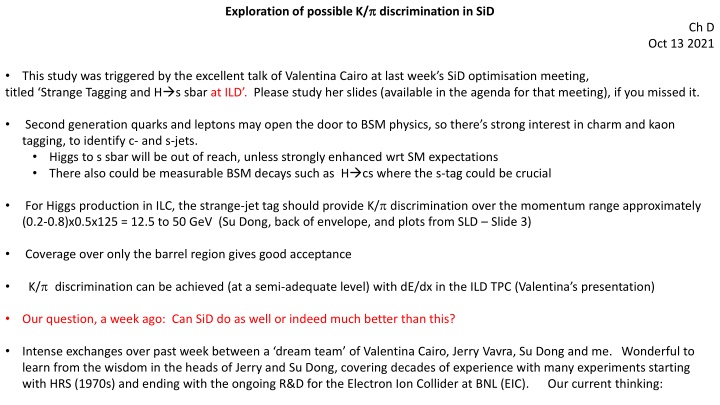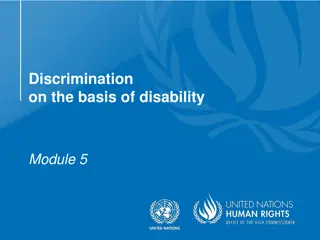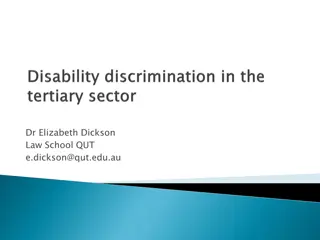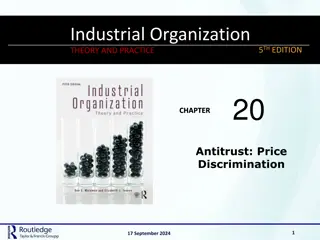
Comprehensive Analysis of Charm and Kaon Tagging for BSM Physics at SiD Ch.D Oct 13, 2021
Explore the potential discrimination of K/ in SiD Ch.D with a focus on strange tagging and Higgs decays to s and sbar. Insights from Valentina Cairo's presentation and discussions with experts reveal the importance of charm and kaon tagging for identifying c- and s-jets in second-generation quarks and leptons. The study delves into the challenges of utilizing dE/dx and the need for innovative approaches like the Ring Imaging Cherenkov system. Notable advancements include discussions on the use of pixel trackers and state-of-the-art radiation detectors. Discover the latest developments and strategies for enhancing BSM physics detection in this in-depth analysis.
Download Presentation

Please find below an Image/Link to download the presentation.
The content on the website is provided AS IS for your information and personal use only. It may not be sold, licensed, or shared on other websites without obtaining consent from the author. If you encounter any issues during the download, it is possible that the publisher has removed the file from their server.
You are allowed to download the files provided on this website for personal or commercial use, subject to the condition that they are used lawfully. All files are the property of their respective owners.
The content on the website is provided AS IS for your information and personal use only. It may not be sold, licensed, or shared on other websites without obtaining consent from the author.
E N D
Presentation Transcript
Exploration of possible K/ discrimination in SiD Ch D Oct 13 2021 titled Strange Tagging and H s sbar at ILD . Please study her slides (available in the agenda for that meeting), if you missed it. Second generation quarks and leptons may open the door to BSM physics, so there s strong interest in charm and kaon tagging, to identify c- and s-jets. Higgs to s sbar will be out of reach, unless strongly enhanced wrt SM expectations There also could be measurable BSM decays such as H cs where the s-tag could be crucial This study was triggered by the excellent talk of Valentina Cairo at last week s SiD optimisation meeting, For Higgs production in ILC, the strange-jet tag should provide K/ discrimination over the momentum range approximately (0.2-0.8)x0.5x125 = 12.5 to 50 GeV (Su Dong, back of envelope, and plots from SLD Slide 3) Coverage over only the barrel region gives good acceptance K/ discrimination can be achieved (at a semi-adequate level) with dE/dx in the ILD TPC (Valentina s presentation) Our question, a week ago: Can SiD do as well or indeed much better than this? Intense exchanges over past week between a dream team of Valentina Cairo, Jerry Vavra, Su Dong and me. Wonderful to learn from the wisdom in the heads of Jerry and Su Dong, covering decades of experience with many experiments starting with HRS (1970s) and ending with the ongoing R&D for the Electron Ion Collider at BNL (EIC). Our current thinking: 1
dE/dx cannot be useful in SiD: it needs ~1 m track length in gas and is disfavoured for solids including silicon due to the density effect, which suppresses the K/ difference in the needed momentum range Ring imaging Cerenkov system is the only realistic approach Electron Ion Collider (EIC) people are making impressive progress with an aerogel radiator, but for our momentum range, a gaseous radiator is mandatory Optimal for SiD .? 2 Antonis Papanestis NIM,A 952 (2020) 162004
K Stefanov, Pixel tracker for SiD, LCWS2021 (first proposed at LCWS Sendai, 2008) Tracking layers are ~0.6% X0 per layer, air cooled 50 m pixels, 5-bit amplitude digitisation, giving 5 m precision in r and z 28 Gpixels, cf 12.5 Gpixels in ITS2 of ALICE a modest increase <100 W dissipation, so air cooled Timing layers are close to ECAL, so can be thicker (evaporative cooling) See Konstantin s LCWS 2021 slides for further details Dimensions of Barrels 1-5 directly follow the old SiD microstrip tracker. Given the enhanced performance of each layer, the pixel tracker can be significantly compressed, for the same performance (still to be simulated) See Konstantin s LCWS 2021 slides for further details 4
Jerry Vavra Looks at first sight like the SLD CRID, but it s in another world of performance ** or MAPMTs (HPK) Extremely thin but excellent optical quality mirrors (Antonis Papanestis) or Stacked EM-MAPS (Sony/RIKEN), potentially 10x10 cm2 buttable, very low power, QE close to 100% Driven by night vision and other commercial applications see my CERN Courier article: https://cerncourier.com/wp-content/uploads/2021/07/CERNCourier2021JulAug-digitaledition.pdf ** Needed radiator thickness will evolve downwards, as QE of photodetectors advances 5
So an important question is, how much will a ring imaging detector expand the radius of the tracker+PID system, if at all? This question can not be answered in a rush, and will need a substantial group of keen young people to study it. ILCX may provide the best chance of recruiting participants for this exciting work [and please be aware of the possible upturn in the prospects for ILC, talks now under way between ILC(Japan) and MEXT] Over to the real leaders of this adventure, Su Dong and Jerry Vavra . 6






















